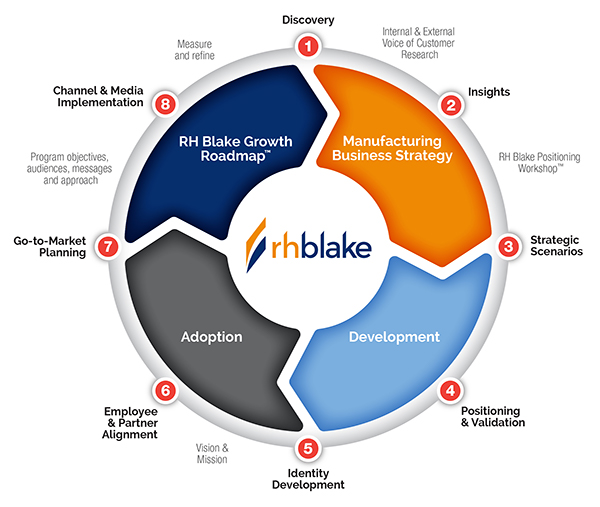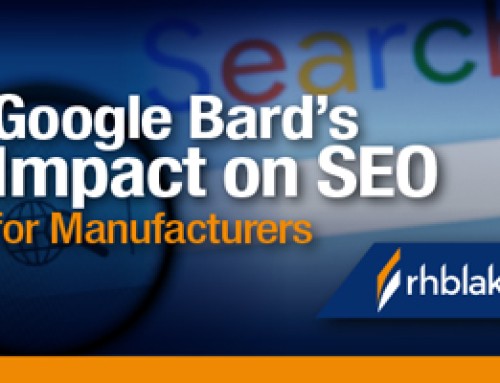Knowing whether or not repositioning your brand is the right course of action starts with defining the why.
Manufacturers considering a change in how they’re perceived in the market are typically facing a significant growth challenge which can be driven by various factors, including a decline in sales, acquisition or merger, increased competition and margin pressure, or planning a major shift in their business direction.
How to Reposition Your Manufacturing Brand for Growth
Written by Dan Konstantinovsky
Strategic Marketing, RH Blake
![]()
Knowing whether or not repositioning your brand is the right course of action starts with defining the why.
Manufacturers considering a change in how they’re perceived in the market are typically facing a significant growth challenge which can be driven by various factors, including a decline in sales, acquisition or merger, increased competition and margin pressure, or planning a major shift in their business direction.
Regardless of the change catalyst, clearly detailing the reasons and desired outcomes are paramount to building a bridge from your current brand state to a successful future one. Below are 8 key elements every manufacturer must consider as part of their repositioning journey.
Manufacturing brand repositioning is not rebranding
First, let’s make an important distinction.
How to Reposition Your Manufacturing Brand for Growth
 Written by Dan Konstantinovsky
Written by Dan Konstantinovsky
Strategic Marketing, RH Blake
![]()
Knowing whether or not repositioning your brand is the right course of action starts with defining the why.
Manufacturers considering a change in how they’re perceived in the market are typically facing a significant growth challenge which can be driven by various factors, including a decline in sales, acquisition or merger, increased competition and margin pressure, or planning a major shift in their business direction.
Regardless of the change catalyst, clearly detailing the reasons and desired outcomes are paramount to building a bridge from your current brand state to a successful future one. Below are 8 key elements every manufacturer must consider as part of their repositioning journey.
Manufacturing brand repositioning is not rebranding
First, let’s make an important distinction.
Rebranding is a wholesale change to your identity. From logo to company name to colors to voice and more. A major merger, stale brand or cripplingly bad publicity might dictate such an extensive transformation.
Pursuing a brand reposition or a complete rebranding effort is a resource-intensive initiative that can have far reaching – favorable and unfavorable – impacts on a business. As a result, going down this path isn’t something that many manufacturers do regularly. However, if market or business factors are compelling you to contemplate repositioning your business, you’ll want to follow a structured and proven process like the one detailed here to achieve your strategic and financial goals.
The essential steps to repositioning your manufacturing brand
Over our 30 years of working with manufacturers and industrial firms, we’ve refined an eight-step process to meticulously guide businesses through the whys and hows of repositioning, including the best ways to take their new messages to market. Those steps are represented in four parts as shown in the illustration.

Part 1: Manufacturing Business Strategy
As stated earlier, thoroughly exploring the whys is where successful repositioning begins. It’s tempting for manufacturers to assume they already understand the reasons well enough to jump forward into development. What tends to happen is a failure to realize all the possibilities and opportunities they can impact. This means coming up short in areas that will have to be addressed in the future. In a worst-case scenario, this requires rethinking and relaunching your positioning, resulting in potentially negative reactions and uncertainty with your target audiences. That amounts to time lost generating new business.
In this part of the process, we perform three activities:
- Discovery: We conduct internal and external interviews and research. These are typically candid discussions based on carefully crafted questions. The biggest input here is the “voice of the customer” research. It’s important to listen to what they say. This step is also supplemented with secondary market and competitive research.
- Insights – RH Blake Positioning Workshop™: With the qualitative research, we form ideas and perspectives that guide an internal workshop to further explore situations and issues and to concretely define the goals and KPIs. One of the main benefits of the workshop is to start developing consensus among the stakeholders. Developing a shared understanding at this point helps facilitate a more efficient process moving forward.
- Strategic Scenarios: At this step, we create desired scenarios that help us formulate messaging recommendations and other adjustments to elicit the preferred new brand perceptions and customer responses.
Part 2: Manufacturing Brand Development
Our main advice for this stage is to prepare for active discussions with an open mind and a willingness to be uncomfortable. Here, we’re exploring what the repositioning changes will look like, from conservative options to more aggressive ones. That’s why open dialogue is critical. You’ll want to embrace what’s at stake, and be willing to support the final direction. Even if the positioning shift might be small, it can feel substantial to organizations that have never had to undergo change before.
There are two steps in this stage:
- Positioning and Validation: This step involves creating the core messaging platform, from your brand promise to the messaging pillars and proof points that will be used with your core audiences. The level of validation depends on the extensiveness of the changes. Minor alterations don’t require the same vetting that major ones do.
- Brand Identity Development: In certain repositioning efforts, modifications to a brand’s visual appearance might be necessary. This could involve alterations to a logo or color palette or the addition of sub-logos to support new departments, services or offerings.
Part 3: Manufacturing Brand Adoption
Critical to the successful rollout of your new positioning is to first secure buy-in with your internal audiences and strategic partners. We call this step Employee and Partner Alignment. It involves clearly communicating the whys and what’s expected of them to help ensure the new positioning is embraced by customers and prospects.
This is an ongoing effort. It should include sharing the successes, both measurable and anecdotal, that your company is experiencing with your target audiences and industry influencers. Over time, these communication efforts will pay dividends in creating enthusiastic support from employees and partners.
Part 4: RH Blake Growth Roadmap™
It’s time to effectively communicate to and with the market. Here is where manufacturers are generally more familiar with the activities that occur: marketing planning and execution. By the nature of our process, the marketing plan actually starts to take shape early on. The research and discussions in the previous steps shed light on future opportunities that we capture and bring to the forefront at this stage.
The focus is first on the launch, but planning also includes determining how to implement the new positioning into all future marketing programs. After all, the primary reason for this change is to drive growth.
The two steps we follow are:
- Go-to-Market Planning: We define marketing program objectives, identify audiences and choose the best marketing channels and media.
- Channel and Media Implementation: Programs and campaigns are executed, monitored and refined to optimize business results.
How to measure your manufacturing brand repositioning efforts
In Part 1, we solidified the business objectives and KPIs for this undertaking. Now it’s a matter of assessing how well the marketing activities achieved those goals.
For example, your goal might have been to increase new customer acquisitions by 10% for the year. Or to sell $500,000 in new services to your customer base. How are you tracking against them?
Monitoring leading and lagging indicators in real time and dissecting performance help you understand how your audience is responding to your new positioning. From here you can optimize your marketing program.
Any repositioning you do will not be an overnight success. However, if you wisely build a bridge that’s believable, relevant and impactful, your customers will cross with you and new target customers will partner with you for the future.
Brand repositioning is about altering the way customers and prospects view your business and offerings. You’re not necessarily changing your corporate identity. You’re making modifications to your appearance, messaging, go-to-market approach and focus to achieve a different place in your target customers’ mind.
Rebranding is a wholesale change to your identity. From logo to company name to colors to voice and more. A major merger, stale brand or cripplingly bad publicity might dictate such an extensive transformation.
Pursuing a brand reposition or a complete rebranding effort is a resource-intensive initiative that can have far reaching – favorable and unfavorable – impacts on a business. As a result, going down this path isn’t something that many manufacturers do regularly. However, if market or business factors are compelling you to contemplate repositioning your business, you’ll want to follow a structured and proven process like the one detailed here to achieve your strategic and financial goals.

The essential steps to repositioning your manufacturing brand
Over our 30 years of working with manufacturers and industrial firms, we’ve refined an eight-step process to meticulously guide businesses through the whys and hows of repositioning, including the best ways to take their new messages to market. Those steps are represented in four parts as shown in the illustration.
Part 1: Manufacturing Business Strategy
As stated earlier, thoroughly exploring the whys is where successful repositioning begins. It’s tempting for manufacturers to assume they already understand the reasons well enough to jump forward into development. What tends to happen is a failure to realize all the possibilities and opportunities they can impact. This means coming up short in areas that will have to be addressed in the future. In a worst-case scenario, this requires rethinking and relaunching your positioning, resulting in potentially negative reactions and uncertainty with your target audiences. That amounts to time lost generating new business.
In this part of the process, we perform three activities:
- Discovery: We conduct internal and external interviews and research. These are typically candid discussions based on carefully crafted questions. The biggest input here is the “voice of the customer” research. It’s important to listen to what they say. This step is also supplemented with secondary market and competitive research.
- Insights – RH Blake Positioning Workshop™: With the qualitative research, we form ideas and perspectives that guide an internal workshop to further explore situations and issues and to concretely define the goals and KPIs. One of the main benefits of the workshop is to start developing consensus among the stakeholders. Developing a shared understanding at this point helps facilitate a more efficient process moving forward.
- Strategic Scenarios: At this step, we create desired scenarios that help us formulate messaging recommendations and other adjustments to elicit the preferred new brand perceptions and customer responses.
Part 2: Manufacturing Brand Development
Our main advice for this stage is to prepare for active discussions with an open mind and a willingness to be uncomfortable. Here, we’re exploring what the repositioning changes will look like, from conservative options to more aggressive ones. That’s why open dialogue is critical. You’ll want to embrace what’s at stake, and be willing to support the final direction. Even if the positioning shift might be small, it can feel substantial to organizations that have never had to undergo change before.
There are two steps in this stage:
- Positioning and Validation: This step involves creating the core messaging platform, from your brand promise to the messaging pillars and proof points that will be used with your core audiences. The level of validation depends on the extensiveness of the changes. Minor alterations don’t require the same vetting that major ones do.
- Brand Identity Development: In certain repositioning efforts, modifications to a brand’s visual appearance might be necessary. This could involve alterations to a logo or color palette or the addition of sub-logos to support new departments, services or offerings.
Part 3: Manufacturing Brand Adoption
Critical to the successful rollout of your new positioning is to first secure buy-in with your internal audiences and strategic partners. We call this step Employee and Partner Alignment. It involves clearly communicating the whys and what’s expected of them to help ensure the new positioning is embraced by customers and prospects.
This is an ongoing effort. It should include sharing the successes, both measurable and anecdotal, that your company is experiencing with your target audiences and industry influencers. Over time, these communication efforts will pay dividends in creating enthusiastic support from employees and partners.
Part 4: RH Blake Growth Roadmap™
It’s time to effectively communicate to and with the market. Here is where manufacturers are generally more familiar with the activities that occur: marketing planning and execution. By the nature of our process, the marketing plan actually starts to take shape early on. The research and discussions in the previous steps shed light on future opportunities that we capture and bring to the forefront at this stage.
The focus is first on the launch, but planning also includes determining how to implement the new positioning into all future marketing programs. After all, the primary reason for this change is to drive growth.
The two steps we follow are:
- Go-to-Market Planning: We define marketing program objectives, identify audiences and choose the best marketing channels and media.
- Channel and Media Implementation: Programs and campaigns are executed, monitored and refined to optimize business results.
How to measure your manufacturing brand repositioning efforts
In Part 1, we solidified the business objectives and KPIs for this undertaking. Now it’s a matter of assessing how well the marketing activities achieved those goals.
For example, your goal might have been to increase new customer acquisitions by 10% for the year. Or to sell $500,000 in new services to your customer base. How are you tracking against them?
Monitoring leading and lagging indicators in real time and dissecting performance help you understand how your audience is responding to your new positioning. From here you can optimize your marketing program.
Any repositioning you do will not be an overnight success. However, if you wisely build a bridge that’s believable, relevant and impactful, your customers will cross with you and new target customers will partner with you for the future.









